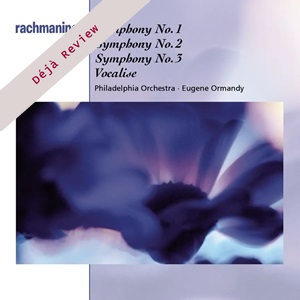
Déjà Review: this review was first published in May 2002 and the recording is still available.
Sergei Rachmaninov (1873-1943)
The Three Symphonies
Symphony No 1 in D minor, Op 13 (1897)
Symphony No 2 in E minor, Op 27 (1907)
Symphony No 3 in A minor, Op 44 (1936)
Vocalise for orchestra, Op 34 No 14 (1915)
Philadelphia Orchestra/Eugene Ormandy
rec. 1966 (No 1), 1959 (No 2), 1967 (No 3 & Vocalise), Town Hall, Philadelphia. ADD
Sony Classics SB2K63257 [2 CDs: 137]
Ormandy’s years with CBS (Sony’s predecessors) stretched from 1943 to 1968 before he took wing to RCA. That period included a smattering of 78s but most of it encompasses the LP era – mono at first then stereo. As can be seen, these famous Rachmaninov sessions date from the last decade of Ormandy’s time with CBS.
The symphonies have been issued repeatedly and in various formats. They were issued first in the USA in the 1960s, finding their way to Europe between 1967 and 1972. The original CBS UK LP numbers are 72571, 77345 and 72674. The oldest recording (No. 2) took some thirteen years to reach the pages of the Gramophone. This was also the era in which CBS recorded Symphonic Dances, The Isle of the Dead and The Bells. If space had permitted I would have wished for the Symphonic Dances on this set even if this meant a different layout and movement split.
Ormandy was Stokowski’s successor at Philadelphia. He curtailed the swashbuckling programme choices and majored on the standard repertoire and established classics. He nurtured Stokowski’s trademark sumptuous string tone and precision of attack. Individual bowing was dropped, but the seamless legato remained steadfast. These qualities are fully in evidence in all four works. I have the impression that the harsh but for me ultimately endearing sound of the original LPs has been softened. Somehow, the extensive cuts in the Second Symphony count for little while you are held in the artists’ hands. The great adagio is done with passionate feeling and with swooping portamenti, which you may well find yourself missing when you hear other more ‘correct’ versions.
All four works are opulent and exciting and though the 1960s sound removes shadings of subtlety, the passion shines through. The First Symphony comes off rather well, though it is not the strongest of works. Glazunov (allegedly the worse for the odd vodka) conducted the premiere that drove the composer into mental breakdown. Glazunov is in fact the composer I thought of most often in this work, which certainly bubbles with coruscating woodwind and brass writing of a quality that shines through Glazunov’s Fourth, Fifth and Eighth Symphonies. The Third Symphony rattled along with all the usual Philadelphian virtues and virtuosity, but I still favour the garish euphoria of the Svetlanov version with the Bolshoi Theatre Orchestra.
These discs have been issued many times before, including on CBS Maestro CD45678. Someone has put some thought into layout this time. In the original, it was the Second Symphony that was split across discs 1 and 2. In this case, the Second Symphony is complete on CD1. It is the rather less coherent First that is split. A similar misjudgement rather takes the gloss off the BMG Melodiya set by Kondrashin. There too we encounter a Second Symphony heavily cut but given an exalted if rather roughened performance.
This is a great bargain and even if you already have say the Ashkenazy, Litton or Previn you should try to hear these. Find reasons why you do not have this as an alternative, displaying the music in the hands of a great orchestra and conductor, each with a Rachmaninov tradition acquired first-hand from contact with the composer.
Forget political correctness (it isn’t difficult with this set) and hold your hand in Ormandy’s flame for the wonderful Second Symphony. A burnished classic of the gramophone.
Rob Barnett
Buying this recording via a link below generates revenue for MWI and helps us keep free access to the site



















